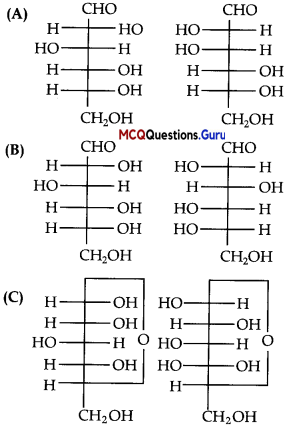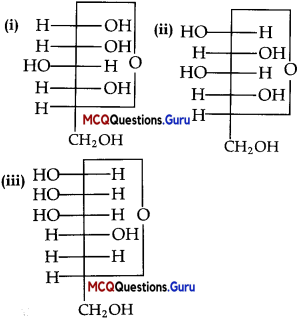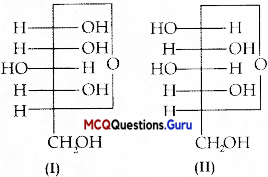Biomolecules Class 12 MCQs Questions with Answers
Biomolecules Class 12 MCQ Chapter 14 Question 1.
Which of the following pairs represents anomers?

Answer:
Option (C) is correct.
Explanation:
The isomers, which differ only in the configuration of the hydroxyl group at C-1, are called anomers and are referred to as a and n-forms.
Biomolecules MCQs Class 12 Chapter 14 Question 2.
Three cyclic structures of monosaccharides are given below which of these are anomers?

(A) (i) and (ii)
(B) (ii) and (iii)
(C) (i) and (iii)
(D) (iii) is anomer of (i) and (ii)
Answer:
(A) (i) and (ii)
Explanation:
Cyclic structures of mono saccharides which differ in structure at carbon-1 are known! as anomers.

Structure (1) and differ in structure at C-1
Biomolecules Class 12 Chemistry MCQ Question 3.
Which of the following is an example of aldohexose?
(A) Ribose
(B) Fructose
(C) Sucrose
(D) Glucose
Answer:
(D) Glucose
Explanation:
Glucose is an example of aldohexose because it contains an aldehyde group.
![]()
MCQ Of Biomolecules Class 12 Chapter 14 Question 4.
Glucose and fructose are:
(A) isomers of each other
(B) Homologous of each other
(C) anomers of each other
(D) enantiomers of each other
Answer:
(A) isomers of each other
Explanation:
Glucose and fructose differ structurally and stereochemicallv. They have same molecular formula i.e. C6H12O6 Hence. these are isomers of each other.
MCQ On Biomolecules Class 12 Chapter 14 Question 5.
Amino acids are:
(A) Acidic
(B) Basic
(C) Amphoteric
(D) Neutral
Answer:
(C) Amphoteric
Explanation:
Amino acids are amphoteric because they contain both basic -NH2 group and acidic -COOH group. ”
Class 12 Chemistry Biomolecules MCQ Question 6.
Which one is the complementary base of cytosine in one strand to that in other strand of DNA?
(A) Adenine
(B) Guanine
(C) Thymine
(D) Uracil
Answer:
(B) Guanine
Explanation:
Guanine (G) is the complementary base of cytosine (C) in one stand to that in other stand of DNA.
![]()
Class 12 Biomolecules MCQs Chapter 14 Question 7.
Curdling of milk is an example of:
(A) breaking of peptide linkage
(B) hydrolysis of lactose
(C) breaking of protein into amino acids
(D) denaturation of protein
Answer:
(D) denaturation of protein
Explanation:
Curdling of milk is an example of denaturation of milk proteins.
Biomolecules MCQ Class 12 Chapter 14 Question 8.
Dinucleotide is obtained by joining two nucleotides together by phosphodiester linkage. Between which carbon atoms of pentose sugars of nucleotides are these linkages present?
(A) 5′ and 3′
(B) Y and 5′
(C) 5′ and 5′
(D) 3′ and 3′
Answer:
(A) 5′ and 3′
Explanation:
These linkages are present between 5′ and 3′ of pentose sugars of nucleotides.
MCQ Biomolecules Class 12 Chapter 14 Question 9.
Proteins are found to have two different types of secondary structures, viz. a-helix and pleated sheet structure, a-helix structure of protein is ‘ stabilised by:
(A) Peptide bonds
(B) van der Waals forces,
(C) Hydrogen bonds
(D) pipole-dipole interactions
Answer:
(C) Hydrogen bonds
Explanation:
a-helix structure of protein is stabilised by hydrogen bonds. A polypeptide chain forms all possible hydrogen bonds by twisting into right-handed helix with the -NH group of each amino acid residue hydrogen bonded to >C=0 of an adjacent turn of helix.
MCQ Questions On Biomolecules Class 12 Question 10.
Lysine
,
(A) a-Amino acid.
(B) Basic amino acid.
(C) Amino acid synthesised in body.
(D) P -Amino acid.
Answer:
Option (A), (B) and (C) is correct.
Explanation:
Lysine whose structure formula is written as :
(i) It is an a-amino acid.
(ii) It is basic amino acid because number of NH2 groups (2) is greater than number of COOH group.
(iii) It is non-essential amino acid because it is synthesized in our body.
![]()
Directions: In the following questions, A statement of Assertion (A) is followed by a statement of Reason (R). Mark the correct choice as.
(A) Both A and R are true and R is the correct explanation of A
(B) Both A and R are true but R is NOT the correct explanation of A
(C) A is true but R is false
(D) A is false and R is True
Class 12 Biomolecules MCQ Chapter 14 Question 1.
Assertion (A): D(+)-Glucose is dextrorotatory in nature.
Reason (R): ‘D’ represents its dextrorotatory nature.
Answer:
(C) A is true but R is false
Explanation:
‘D’ corresponds to the position of – OH group on the right side on the farthest asymmetric C-atom.
Biomolecules MCQ Questions Class 12 Chapter 14 Question 2.
Assertion (A): Deoxyribose, C5H10O4 is not a carbohydrate.
Reason (R): Carbohydrates are optically active polyhydroxy aldehyde or polyhydroxy ketone or substances which give aldehyde or ketone on hydrolysis.
Answer:
(D) A is false and R is True
Explanation:
Deoxyribose, C5H10O4 is a carbohydrate and is the sugar moiety of DNA.
Chemistry Biomolecules Class 12 MCQ Chapter 14 Question 3.
Assertion (A): Glucose reacts with hydroxylamine to form an oxime and also adds a molecule of hy-drogen cyanide to give cyanohydrin.
Reason (R): The carbonyl group is present in llie openchain structure of glucose.
Answer:
(A) Both A and R are true and R is the correct explanation of A
Explanation:
Glucose reacts with hvdroxvlamine to form an oxime and also adds a molecule of hydrogen cyanide to give cyanohydrin which confirms the presence of the carbonyl group in the open chain structure of glucose.
Class 12 Chemistry Chapter 14 Biomolecules MCQ Question 4.
Assertion (A): The two strands of DNA are complementary to each other.
Reason (R): The hydrogen bonds are formed between specific pairs of bases.
Answer:
(A) Both A and R are true and R is the correct explanation of A
Explanation:
The two strands of DNA are complementary in each other and hydrogen bonds are formed between specific pairs of bases,
![]()
MCQs Of Biomolecules Class 12 Chapter 14 Question 5.
Assertion (A): All naturally occurring a amino acids except glycine are optically active.
Reason (R): Most naturally occurring a amino acids have L-configuration.
Answer:
(B) Both A and R are true but R is NOT the correct explanation of A
Explanation:
Most of the naturally occurring amino acids have L-configuration. All naturally occurring a-amino acids are optically active except glycine.
Question 6.
Assertion (A): Glycine must be taken through diet
Reason (R): It is non-essential amino acid.
Answer:
(D) A is false and R is True
Explanation:
Glycine must not be taken through diet because it can be synthesized in our body and a non-essential amino acid.
I. Read the passage given below and answer the following questions:
Evidence For The Fibrous Nature Of Dna:
The basic chemical formula of DNA is now well established. As shown in Figure 1 it consists of a very long chain, the backbone of which is made up of alternate sugar and phosphate groups, joined together in regular 3′ 5′ phosphate di-ester linkages. To each sugar is attached a nitrogenous base, only four different kinds of which are commonly found in DNA. Two of these-adenine and guanine are purines, and the other two thymine and cytosine-are pyrimidines.
![]()
A fifth base, 5-methyl cytosine, occurs in smaller amounts in certain organisms, and a sixth, 5-hydroxy-methyl-cytosine, is found instead of cytosine in the T even phages. It should be noted that the chain is unbranched, a consequence of the regular internucleotide linkage. On the other hand the sequence of the different nucleotides is, as far as can be ascertained, completely irregular.
Thus, DNA has some features which are regular, and some which are irregular. A similar conception of the DNA molecule as a long thin fiber is obtained from physicochemical analysis involving sedimentation, diffusion, light scattering, and viscosity measurements. These techniques indicate that DNA is a very asymmetrical structure approximately 20 A wide and many thousands of angstroms long.
Estimates of its molecular weight currently center between 5 X106 and X107 (approximately 3 X104 nucleotides). Surprisingly each of these measurements tend to suggest that the DNA is relatively rigid, a puzzling finding in view of the large number of single bonds (5 per nucleotide) in the phosphate-sugar back bone. Recently these indirect inferences have been confirmed by electron microscopy.
Question 1.
Purines present in DNA are:
(A) adenine and thymine
(B) guanine and thymine
(C) cytosine and thymine
(D) adenine and guanine
Answer:
(D) adenine and guanine
Explanation:
Adenine and guanine are associated to form the adenine-thymine and guanine-1 cytosine base pairs.
Question 2.
DNA molecule has ………….. internucleotide linkage and ………….. sequence of the different nucleotides
(A) regular, regular
(B) regular, irregular
(C) irregular, regular
(D) irregular, irregular
Answer:
(B) regular, irregular
Explanation:
DNA molecule has regular inlernucleotide linkage and irregular sequence of the different nucleotides.
![]()
Question 3.
DNA has a ………….. backbone
(A) phosphate-purine
(B) pyrimidines-sugar
(C) phosphate-sugar
(D) purine-pyrimidine
Answer:
(C) phosphate-sugar
Explanation:
the backbone of DNA is made up of Deoxvribose (Sugar) molecule connected to each other using hosphates.
Question 4.
Out of the four different kinds of nitrogenous bases which are commonly found in DNA ………….. has been replaced in some organisms.
(A) adenine
(B) guanine
(C) cytosine
(D) thymine
Answer:
(C) cytosine
Explanation:
A chemical compound that is used to make one of the building blocks of DNA and RNA. It is a type of pyrimidine, i.c., cytosine.
II. Read the passage given below and answer the following questions:
The two monosaccharides are joined together by an oxide linkage formed by the loss of a water molecule. Such a linkage between two monosaccharide units through oxygen atom is called glycosidic linkage. In disaccharides, if the reducing groups of monosaccharides i.e., aldehydic or ketonic groups are bonded, these are non-reducing sugars, e.g., sucrose.
On the other hand, sugars in which these functional groups are free, are called reducing sugars, for example, maltose and lactose. A non reducing disaccharide ‘A on hydrolysis with dilute acid gives an equimolar mixture of D-(+)- glucose and D-(-)-Fructose.

Question 1.
In the above reaction, reactant A is:
(A) Glucose
(B) Sucrose
(C) Maltose
(D) Fructose
Answer:
(B) Sucrose
Explanation:
![]()
Question 2.
What is the mixture of D-(+) glucose and D-(+) fructose known as ?
(A) Anomers
(B) Racemic mixture
(C) Invert sugar
(D) Optical mixture
Answer:
(C) Invert sugar
Explanation:
The mixture of D-(+)- glucose and D-(-)-Fructose is known as invert sugar,
![]()
Question 3.
Name the linkage that holds the two units in the disaccharide ?
(A) Nucleoside linkage
(B) Glycosidic linkage
(C) Peptide linkage
(D) None of the above
Answer:
(B) Glycosidic linkage
Explanation:
The linkage which holds the two I monosaccharide units through oxygen atom is called glycosidic linkage.
Question 4.
Glucose on reaction with acetic acid gives glucose pentaacetate. What does it suggest about the structure of glucose ?
(A) C-l is anomeric carbon
(B) C-5 is anomeric carbon
(C) 3′-OH groups are present
(D) 5′-OH groups are present
Answer:
(D) 5′-OH groups are present
Explanation:
It indicates that 5′-OH groups are present which react with acetic acid to give glucose penluacelate.
OR
Proteins are found to have two different types of secondary structures, viz. a-helix and fl-pleated sheet structure, a-helix structure of protein is stabilised by
(A) Peptide bonds
(B) vain der Waals forces
(C) Hydrogen bonds
(D) Dipole-dipole interactions
Answer:
(C) Hydrogen bonds
Explanation:
cx-helix structure of protein is stabilised by hvdrogen bonds. A polypeptide chain forms all possible hydrogen bonds by twisting into right-handed helix with the -NH group of each amino acid residue hydrogen bonded to >C=0 of an adjacent turn of helix.
III. Read the passage given below and answer the following questions:
The sequence of bases in m-RNA are read in a serial order in groups of three at a time. Each triplet of nucleotides (having a specific sequence of bases) is known as codon. Each codon specifies one amino acid. Many amino acids have more than one codons. The amino acids are brought to the mRNA by another type of RNA and called tRNA. Each amino acid has atleast one corresponding tRNA. At one end of the tRNA molecule is a trinucleotide base sequence that is complementary to some trinucleotide base sequence on mRNA.
Question 1.
Which of the following nitrogen bases is not present in RNA?
(A) Thymine
(B) Adenine
(C) Guanine
(D) Cytosine
Answer:
(A) Thymine
Explanation:
In RNA, thymine is not present. in place of thymine, uracil is present in RNA.
![]()
Question 2.
Each triplet of nucleotides is called:
(A) Anticodon
(B) Codon
(C) mRNA
(D) tRNA
Answer:
(B) Codon
Explanation:
Each triplet of nucleotides, which have a specific sequence of bases, is called codon.
Question 3.
Each codon specifies:
(A) 1 amino acid
(B) 2 amino acids
(C) 3 amino acids
(D) None of these
Answer:
(A) 1 amino acid
Explanation:
Each codon specifies one amino acid. Manv amino acids possess more than one codons.
Question 4.
In mRNA, the complementary bases of AAT is:
(A) CCG
(B) UUA
(C) AUU
(D) UUU
Answer:
(B) UUA
Explanation:
In mRNA So, the complementary bases of AAT in mRNA is ILUA.
OR
The amino acids are brought to the mRNA by:
(A) rRNA
(B) DNA
(C) tRNA
(D) None of these
Answer:
(C) tRNA
Explanation:
The amino acids are brought to the mRNA by tRNA (transfer RNA).
![]()
IV Read the passage given below and answer the following questions:
Adenosine triphosphate (ATP) is the energy¬carrying molecule found in the cells of all living things. ATP captures chemical energy obtained from the breakdown of food molecules and releases it to fuel other cellular processes. ATP is a nucleotide that consists of three main structures: the nitrogenous base, adenine; the sugar, ribose; – and a chain of three phosphate groups bound to ribose. The phosphate tail of ATP is the actual power source which the cell taps.
Available energy is contained in the bonds between the phosphates and is released when they are broken, which occurs through the addition of a water molecule (a process called hydrolysis). Usually only the outer phosphate is removed from ATP to yield energy; when this occurs ATP is converted to adenosine diphosphate (ADP), the form of the nucleotide having only two phosphates.
The importance of ATP (adenosine triphosphate) as the main source of chemical energy in living matter and its involvement in cellular processes has long been recognized. The primary mechanism whereby higher organisms, including humans, generate ATP is through mitochondrial oxidative phosphorylation. For the majority of organs, the main metabolic fuel is glucose, which in the presence of oxygen undergoes complete combustion to C02 and H20:
C6H12O6 + 6O2 + 6O2 + 6H2O + energy
The free energy (AG) liberated in this exergonic (AG is negative) reaction is partially trapped as ATP in two consecutive processes: glycolysis (cytosol) and oxidative phosphorylation (mitochondria). The first produces 2 mol of ATP per mol of glucose, and the second 36 mol of ATP per mol of glucose. Thus, oxidative phosphorylation yields 17-18 times as much useful energy in the form of ATP as can be obtained from the same amount of glucose by glycolysis alone.
The efficiency of glucose metabolism is the ratio of amount of energy produced when 1 mol of glucose oxidised in cell to the enthalpy of combustion of glucose. The energy lost in the process is in the form of heat. This heat is responsible for keeping us warm.
![]()
The following questions are multiple choice questions. Choose the most appropriate answer:
Question 1.
Cellular oxidation of glucose is a:
(A) spontaneous and endothermic process
(B) non spontaneous and exothermic process
(C) non spontaneous and endothermic process
(D) spontaneous and exothermic process
Answer:
(D) spontaneous and exothermic process
Question 2.
What is the efficiency of glucose metabolism if mole of glucose gives 38ATP energy?
(Given: The enthalpy of combustion of glucose is 686 kcal, ATP = 7.3kcal)
(A) 100%
(B) 38%
(C) 62%
(D) 80%
Answer:
(B) 38%
Explanation:
Glucose catabolism yields a Total of 38 ATP. 38 ATP x 7.3 kcnl/mol ATP = 262 kcal. Glucose has 686 kcal. Thus the efficiency of glucose metabolism is 262/686 x 100 = 38%.
Question 3.
Which of the following statement is true?
(A) ATP is a nucleoside made up of nitrogenous base adenine and ribose sugar.
(B) ATP consists the nitrogenous base, adenine and the sugar, deoxyribose.
(C) ATP is a nucleotide which contains a chain of three phosphate groups bound to ribose sugar.
(D) The nitrogenous base of ATP is the actual power source.
Answer:
(C) ATP is a nucleotide which contains a chain of three phosphate groups bound to ribose sugar.
Question 4.
Nearly 95% of the energy released during cellular respiration is due to:
(A) glycolysis occurring in cytosol
(B) oxidative phosphorylation occurring in cytosol
(C) glycolysis in occurring mitochondria
(D) oxidative phosphorylation occurring in mitochondria
Answer:
(D) oxidative phosphorylation occurring in mitochondria
![]()
Question 5.
Which of the following statements is correct:
(A) ATP is a nucleotide which has three phosphate groups while ADP is a nucleoside which three phosphate groups.
(B) ADP contains a nitrogenous bases adenine, ribose sugar and two phosphate groups bound to ribose.
(C) ADP is the main source of chemical energy in living matter.
(D) ATP and ADP are nucleosides which differ in number of phosphate groups.
Answer:
(B) ADP contains a nitrogenous bases adenine, ribose sugar and two phosphate groups bound to ribose.